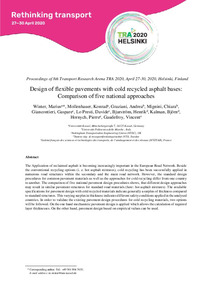| dc.date.accessioned | 2020-03-13T14:02:39Z | |
| dc.date.available | 2020-03-13T14:02:39Z | |
| dc.date.issued | 2020 | |
| dc.identifier | doi:10.17170/kobra-202003131063 | |
| dc.identifier.uri | http://hdl.handle.net/123456789/11477 | |
| dc.description | Marius Winter, Konrad Mollenhauer & Andrea Graziani (2020, April 27-30). Design of flexible pavements with cold recycled asphalt bases: Comparison of five national approaches. Transport Research Arena 2020, Helsinki, Finland. (Conference canceled) | |
| dc.description.sponsorship | The work reported here is part of the project “CRABforOERE – Cold recycled asphalt bases for optimized energy & resource efficient pavements” funded by the CEDR Transnational Road Research Programme Call 2017: Materials funded by Austria, Belgium-Flanders, Denmark, Germany, Netherlands, Norway, Slovenia, Sweden and the United Kingdom. | ger |
| dc.language.iso | eng | eng |
| dc.rights | Urheberrechtlich geschützt | |
| dc.rights.uri | https://rightsstatements.org/page/InC/1.0/ | |
| dc.subject.ddc | 710 | |
| dc.subject.ddc | 620 | |
| dc.title | Design of flexible pavements with cold recycled asphalt bases: Comparison of five national approaches | eng |
| dc.type | Konferenzveröffentlichung | |
| dcterms.abstract | The Application of reclaimed asphalt is becoming increasingly important in the European Road Network. Beside the conventional recycling options (i. e. hot asphalt mixtures), cold recycling has been successfully applied in numerous road structures within the secondary and the main road network. However, the standard design procedures for common pavement materials as well as the approaches for cold recycling differ from one country to another. The comparison of five national pavement design procedures shows, that different design approaches may result in similar pavement structures for standard road materials (here: hot asphalt mixtures). The available specifications for pavement design with cold recycled materials indicate generally a surplus of thickness compared to standard structures. This varying surplus in thickness indicates different safety conditions applied in the analysed countries. In order to validate the existing pavement design procedures for cold recycling materials, two options will be followed. On the one hand mechanistic pavement design is applied which allows the calculation of required layer thicknesses. On the other hand, pavement design based on empirical values can be used. | eng |
| dcterms.accessRights | open access | |
| dcterms.alternative | Proceedings of 8th Transport Research Arena TRA 2020, April 27-30, 2020 | eng |
| dcterms.creator | Winter, Marius | |
| dcterms.creator | Mollenhauer, Konrad | |
| dcterms.creator | Graziani, Andrea | |
| dcterms.creator | Mignini, Chiara | |
| dcterms.creator | Giancontieri, Gaspare | |
| dcterms.creator | Lo Presti, Davide | |
| dcterms.creator | Bjurström, Henrik | |
| dcterms.creator | Kalman, Björn | |
| dcterms.creator | Hornych, Pierre | |
| dcterms.creator | Gaudefroy, Vincent | |
| dcterms.extent | 10 Seiten | |
| dc.subject.swd | Straßenbau | ger |
| dc.subject.swd | Asphalt | ger |
| dc.subject.swd | Recycling | ger |
| dc.type.version | publishedVersion | |
| dcterms.event.date | 2020-04 | |
| dcterms.event.place | Helsinki, Finland | |
| kup.iskup | false | |
| dcterms.event | Rethinking transport | eng |

